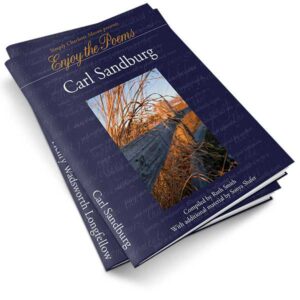Free shipping on USA orders over $129!


Over the past few weeks I have been gleaning much from two people who are nearly as opposite as opposite can be: Henry Wadsworth Longfellow and Carl Sandburg. About the only things they have in common are that they were both men and were both poets.
They lived in different generations. Their lives overlapped by just four years; Carl Sandburg was four years old when Longfellow died.
Their poetry styles are completely different. Longfellow focused on rhyme, on telling vivid stories and describing beautiful nature scenes, on drawing from deep stores of literary and mythological references.
Sandburg honed his skill in free verse and focused on modern vignettes of common people in the city and the prairie. His style was to paint striking images using poignant, powerful words or sometimes playing with imaginative words.
Two vastly different poets, yet I have discovered many precious gems of ideas tucked into both men’s work. And we’re pleased to share them with you and your students, for they are the next two poets in our Enjoy the Poems series.
Your students will glean ideas from Longfellow about the value of work,
“For his heart was in his work, and the heart
Giveth grace unto every Art.”
about the power of a thought,
“Ah! what a wondrous thing it is
To note how many wheels of toil
One thought, one word, can set in motion!”
about inevitable ups and downs.
“Into each life some rain must fall.”
Plus ideas from Sandburg about peaceful nighttime,
“Dark listening to dark.”
about our fellow man,
“I have had my chance to live with people who have too much and the people who have too little.”
about viewing nature in a personal way.
“The willows drowse and sleep on the shoulders of the running water.”
Each Enjoy the Poems book contains 26 of the selected poet’s poems, a suggested schedule, and practical tips to help you enjoy them. A living biography is included, as well as pages for illustrating any poems you choose.
Longfellow and Sandburg lived in two different generations with two completely different styles of poetry. Yet both have much to offer toward “cultivating the seeing eye, the hearing ear, the generous heart” in our students and in ourselves (Vol. 5, p. 224).

We started using SCM this fall and we are using Enrichment Studies 1 so that means Robert Louis Stevenson has been giving us sweet little breaks in the day a couple of times per week. The gentle way of reading the poem, “My Shadow,” throughout the weeks (and I posted copies in each bathroom) has made it so easy for the kids to memorize. They have also gotten to know a little bit about Mr. Stevenson’s sickly childhood and adventures as he grew up. Thanks for making this so doable for us with the booklet. I am excited to finish up with him and move on to the next one so that we can see the differences in style. What a thorough way to develop a love for poetry. I can’t imagine homeschooling any other way than the way you have delightfully laid things out for us. It’s all been very helpful and I appreciate the work you have put into your company.
Melissa